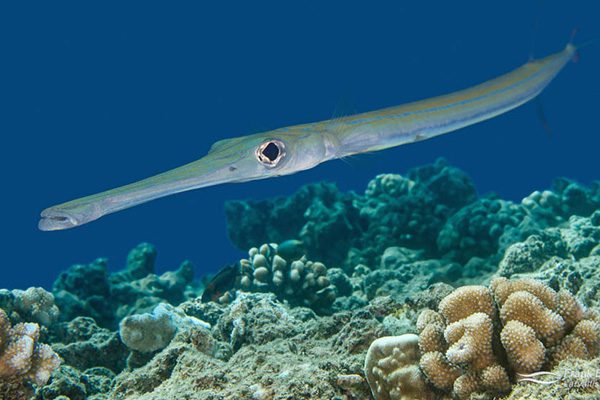The Ethereal Stalker: Ecology & Dynamics of Cornetfish (Fistularia commersonii) in Marsa Alam
In the vast blue expanse of Marsa Alam’s Red Sea, where the vibrant reef buzzes with constant activity, an almost invisible drama unfolds with exquisite precision. The Cornetfish (Fistularia commersonii), a master of stealth and a creature of ethereal grace, embodies the very essence of silent predation. Far from a mere curiosity, this elongated fish plays a crucial ecological role as a specialized hunter, maintaining the delicate balance of the reef’s smaller populations. Sambo Divers Marsa Alam invites you to explore the fascinating dynamics and the vital importance of this remarkable, often unseen, stalker.
Patience and Precision: The Hunting Techniques of Fistularia commersonii
The Cornetfish’s entire being is a finely tuned instrument of the hunt. Its unique anatomy and behavior combine to create a highly effective predator:
- Mimicry as a Weapon: Unlike more active pursuit predators, the Cornetfish relies heavily on mimicry. It often positions itself horizontally or at a slight angle, swaying gently with the current, effortlessly blending in with floating debris, branches, or seagrass blades. This perfect impersonation allows it to drift imperceptibly close to unsuspecting prey, often small reef fish or shrimp, without triggering any alarm.
- The Stealthy Glide: When it needs to move, its elongated body allows for incredibly smooth, almost imperceptible locomotion. It glides rather than swims, making no sudden movements that might alert its next meal. This slow, deliberate approach is key to its ambush strategy.
- “Shadowing” Strategy: Similar to its relative, the Trumpetfish, Fistularia commersonii has been observed utilizing larger, harmless fish as a living “moving screen.” By positioning itself directly behind a grazing parrotfish or a slow-moving grouper, the Cornetfish can approach its prey undetected, using the larger fish as camouflage until it is within striking distance. This intricate behavioral adaptation highlights the complex interspecies relationships on the reef.
- Explosive Suction Feeding: The final act of the hunt is a rapid, explosive lunge. Its long, tubular mouth can expand with incredible speed, creating a powerful vacuum that sucks in its prey. This highly efficient “gape-and-suck” method ensures a quick and effective capture.
- Diet: The Cornetfish’s diet primarily consists of small reef fish (juvenile wrasses, gobies, blennies) and various invertebrates, particularly shrimp. By predating on these smaller organisms, it contributes to the natural regulation of their populations.
Ecological Role: A Balanced Predator in the Red Sea
While not forming large, visible schools, the Cornetfish’s presence is important for the overall health of Marsa Alam’s reef ecosystem:
- Population Regulation: As a specialized predator of smaller fish and crustaceans, it plays a role in preventing overpopulation of certain species, which could otherwise impact the reef’s delicate balance by overgrazing algae or competing for resources.
- Indicator of Healthy Habitats: Its reliance on camouflage and a steady supply of small prey means that healthy Cornetfish populations often indicate a diverse and robust reef environment with intact physical structures and a thriving community of smaller organisms.
- Subtle Connections: Its interactions with other species, like its “shadowing” behavior, demonstrate the intricate, often unseen, connections that weave through the entire ecosystem.
Threats and Conservation
Generally, Cornetfish are not a target for commercial fisheries, offering them some protection. However, like all reef dwellers, they are vulnerable to broader environmental threats:
- Habitat Degradation: The loss or degradation of their preferred habitats – healthy coral reefs, seagrass beds, and sandy channels – due to climate change, pollution, or physical damage directly impacts their ability to hunt and survive.
- Climate Change: Rising sea temperatures and ocean acidification threaten the fundamental health of the coral reefs and seagrass meadows that provide their essential camouflage and prey base.
- Water Quality: Polluted waters can reduce their prey availability and directly impact their health.
Sambo Divers Marsa Alam: Understanding the Unseen Wonders
The Cornetfish (Fistularia commersonii) in Marsa Alam is a testament to the elegant strategies of survival and predation in the Red Sea. Sambo Divers Marsa Alam is dedicated to fostering a deeper understanding of all marine life, even those masters of stealth:
- Expert Guidance: Our experienced dive guides are adept at spotting these camouflaged wonders, providing you with a unique opportunity to observe their incredible adaptations without disturbing them.
- Respectful Observation: We emphasize slow, controlled movements and maintaining a respectful distance to ensure you don’t inadvertently disrupt their hunting activities or stress them.
- Ecosystem Appreciation: By highlighting the Cornetfish’s specialized role, we help divers understand the intricate web of life on the reef and the importance of preserving every component of this magnificent ecosystem.
To witness the ethereal grace and cunning strategies of the Cornetfish (Fistularia commersonii) in Marsa Alam is to unlock a hidden layer of the Red Sea’s extraordinary marine world. Join Sambo Divers Marsa Alam for an enriching dive experience, where the silent hunters reveal the profound artistry of nature.




0 Comment